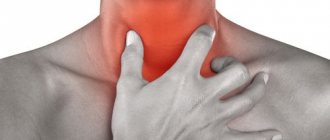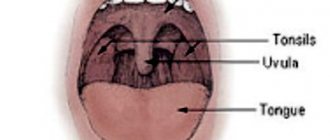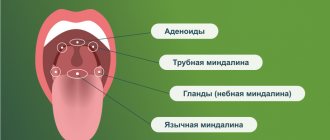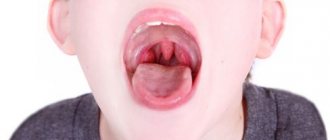Every person experiences a sore throat sooner or later. But this seemingly harmless symptom can cause serious problems.
Acute tonsillitis (tonsillitis) is an infectious disease that causes inflammation of the tonsils. Statistics show that about 15% of children suffer from an acute form of the disease. In the adult population, this figure is lower - 5-10%. But almost every person in large cities suffers from chronic tonsillitis. Why? Let's find out!
The acute form of tonsillitis, which goes away with an increase in body temperature and severe pain in the throat, is more familiar to us as a sore throat. In the chronic form, the patient may not even realize that he has this disease for a long time. A person may feel that periodic sore throats and frequent colds are simply the result of a weakened immune system. Such a careless attitude towards one’s health can cause serious complications and pathologies. To avoid them, it is necessary to diagnose the problem in time: know the first signs, symptoms and treatment.
Make an appointment right now!
Call us by phone or use the feedback form
Sign up
Why are tonsils needed?
The tonsils are an integral part of our immune system. And their main purpose is to protect the body from the penetration of pathogenic bacteria and viruses. In total, a person has six of them: palatine and tubal (paired), pharyngeal and lingual. By their names you can roughly understand in which part of the pharynx they are located. Their general arrangement resembles a ring. This ring acts as a kind of barrier for bacteria. When we talk about inflammation of the tonsils, we mean only the palatine tonsils (aka tonsils). Let's look at them in more detail.
If you open your mouth wide, then in the mirror you can easily see two formations that look like almonds - tonsils, these are tonsils. Each tonsil consists of small openings (lacunae) and winding canals (crypts).
Bacteria that enter the air, in contact with the tonsils, are rebuffed and are immediately disposed of, without having time to cause an outbreak of a particular disease. Normally, a healthy person does not even suspect that real fighting is taking place inside him. Now you understand the importance of the mission of the palatine tonsils. Therefore, a good otolaryngologist will never rush to recommend their removal. Although to hear from a doctor, speaking about tonsils: “They need to be removed!” - a common phenomenon in our time. Unfortunately, today not all clinics can offer high-quality treatment for tonsillitis, and sometimes the turnaround rate is off the charts. That is why it is sometimes easier for a doctor to brush it off and refer the patient for surgery.
Types of tonsillitis.
The disease occurs in two forms - acute and chronic. Acute tonsillitis is an illness of an infectious nature and manifests itself in acute inflammation of the tonsil. The cause of exacerbation is staphylococci and streptococci. Acute sore throat in children and adults is also divided into catarrhal, follicular, lacunar, ulcerative-membranous and necrotic.
Chronic tonsillitis is a long-term, persistent inflammatory process in the tonsils. It manifests itself as a consequence of past inflammation, acute respiratory viral infections, dental diseases, and reduced immunity. Chronic exacerbation of the disease in adults and children occurs in three forms: compensated, subcompensated and decompensated. In the compensated form, the disease “dormants”; exacerbation of tonsillitis symptoms occurs infrequently. In the case of a subcompensated form of the disease, exacerbations occur frequently, the disease is severe, and complications are common. The decompensated form is characterized by a long, sluggish course.
Clinical manifestations
The symptoms of tonsillitis depend on its form, which can be simple or toxic-allergic.
Signs of a simple form:
- Exacerbations no more than 1-2 times a year;
- Between exacerbations the general condition is not disturbed;
- There are no systemic manifestations of tonsillitis (no damage to other organs, no intoxication, general condition does not suffer);
- Local manifestations of the inflammatory process.
Signs of the toxic-allergic form are:
- Changes in the blood (they are detected by general clinical, biochemical and immunological analysis);
- Tonsillogenic intoxication;
- Symptoms of damage to internal organs (heart, blood vessels, kidneys, etc.), which are associated with the development of rheumatism, glomerulonephritis, vasculitis, septic endocarditis, etc.
Taking into account the severity of clinical symptoms, the toxic-allergic form can be grade 1 or 2. The differences between them are taken into account by B.S. Preobrazhensky’s classification.
Symptoms of tonsillitis.
A symptom that combines both types is pain in the throat. The pain can be both severe and tolerable. The patient experiences severe discomfort while eating and swallowing.
Sore throat is much more severe than a chronic disease and is accompanied by the following symptoms:
- increased body temperature (up to 40°C);
- very severe sore throat;
- enlarged lymph nodes;
- accumulations of pus on the tonsils (plaque, pustules);
- enlarged tonsils;
- headache;
- weakness.
The symptoms and treatment of chronic tonsillitis are somewhat different from the manifestations of tonsillitis. With a chronic disease, the temperature remains at 37°C. A sore throat, cough, and bad breath are added. There is a white coating on the tonsils. The symptoms are less pronounced, since the course of the disease itself is characterized by remissions and exacerbations. A patient suffering from a chronic form of the disease loses his ability to work, gets tired quickly, and loses his appetite. Often a person suffers from insomnia.
Possible complications.
Both forms of the disease: chronic and acute, can cause serious complications. One of the most severe consequences of the disease is rheumatism. Practice shows that half of the patients suffering from rheumatism had to be treated for chronic tonsillitis or treated for acute conditions a month earlier. The disease itself begins with unbearable joint pain and increased body temperature.
There are frequent cases of heart disease caused by tonsillitis. Patients experience shortness of breath, interruptions in the functioning of the heart muscle, and tachycardia. Myocarditis may develop.
If inflammation spreads to tissues nearby the tonsil, paratonsillitis appears. The patient suffers from a sore throat and fever. If the infection from the tonsils spreads to the lymph nodes, lymphadenitis appears.
Untreated tonsillitis also leads to kidney disease.
Diagnosis of the disease
A diagnostic search for chronic tonsillitis is not only making a diagnosis, but also determining the form of the disease. Therefore, the examination is always comprehensive, which includes:
- Objective examination data (redness, swelling, injection of blood vessels on the tonsil mucosa, etc.);
- Survey – assessment of complaints, the history of their occurrence and other anamnestic information;
- Microbiological examination (seeding pathological secretions taken from lacunae on special media to determine the causative microbe, as well as its sensitivity to antimicrobial drugs);
- Laboratory tests (blood, urine);
- Instrumental examinations (ECG, ultrasound of the heart and lymph nodes).
Assessment of these parameters allows you to correctly determine the stage of the inflammatory process and optimally select treatment.
| Examination method | Signs | What does the examination give? |
| Collection of anamnesis and complaints | Pain and discomfort in the throat, sensation of a lump or foreign body, heart and joint pain, general weakness, malaise. Single or multiple exacerbations of tonsillitis throughout the year. | Allows you to suspect chronic tonsillitis and the stage of the process, and evaluate the effectiveness of the treatment. |
| Pharyngoscopy | Pus or purulent plugs on the surface of the tonsils (pathological secretion fills the lacunae). Redness, infiltration and swelling of the arches of the palate, their cicatricial fusion with the tonsil. | Confirms the diagnosis of chronic tonsillitis, but does not allow assessing the stage of the process. Allows you to evaluate the effectiveness of conservative treatment. |
| Bacteriological examination | Identification of the microorganism and its sensitivity to antibacterial therapy. | Allows you to identify the causative microorganism and select the necessary treatment. Assess the effectiveness of conservative treatment. |
| Laboratory diagnostics | Clinical blood test, biochemical blood test (urea, creatinine, ALT, AST), C-reactive protein, ASLO, rheumatoid factor, IgE, total blood IgA. | Allows you to determine the activity of inflammation, identify the risk of development or the presence of concomitant diseases (rheumatism, glomerulonephritis, polyarthritis, infective endocarditis, etc.) Helps choose treatment tactics, evaluate the effectiveness of treatment. |
| Functional diagnostics | ECG (electrocardiogram) Echo-CG (ultrasound of the heart) Ultrasound of the kidneys Ultrasound of the lymph nodes of the neck. | Helps determine the stage of chronic tonsillitis, identify the presence of associated diseases (rheumatism, glomerulonephritis, polyarthritis, infective endocarditis, etc.) Helps choose treatment tactics. |
Pregnancy and chronic tonsillitis.
The health of the expectant mother and baby requires close attention. Complications caused by the disease can lead to dangerous consequences, including miscarriage or provoke premature birth. Self-medication in this case is dangerous: it is necessary to undergo treatment with an ENT specialist in the clinic. The doctor will prescribe washing the tonsils, treating them with ultrasound and gargling with antiseptics that are safe for the expectant mother. Physiotherapy is contraindicated for pregnant women.
If you are just planning a pregnancy, it is worth carrying out planned therapy for prevention in order to reduce the negative impact of pathogens on the tonsils. At the planning stage of pregnancy, it is recommended that both parents undergo an examination to reduce the risk of this disease in the child.
Friends! Timely and correct treatment will ensure you a speedy recovery!
Acute tonsillitis. Treatment.
Self-medication for this disease is unacceptable! To choose an effective method of treatment during exacerbation, it is necessary to treat tonsillitis in children and adults under the supervision of an ENT doctor. It should be remembered that the acute form of the disease is extremely contagious. When the first signs of the disease appear, a number of measures must be taken to promote a speedy recovery of the patient:
- the sick person must be isolated by placing in another room. He must have his own towel, linen and dishes, since the disease is very contagious;
- during the treatment period the patient is prescribed strict bed rest;
- take care of the patient’s nutrition: food should not be solid, so as not to cause unnecessary concern to the sore throat;
- do not forget about drinking plenty of fluids;
- a course of antibacterial therapy is prescribed (Amoxiclav, Azithromycin, etc.). It is necessary to completely drink the entire course of antibiotics, even if the patient feels a noticeable improvement;
- For local treatment, drugs with an antibacterial effect are used;
- when treating a throat with tonsillitis, the drugs “Tantum-verde”, “Inhalipt”,
- rinsing with antiseptics (“Chlorgequidine”, “Furacilin”);
- lubricating the tonsils with Lugol's solution;
- to relieve swelling of the tonsils, you need to take allergy medications;
- If your body temperature is above 38°C, take antipyretics based on ibuprofen or paracetamol.
Sore throat: how to quickly cure a sore throat, tonsils, tonsillitis
In this article we will talk about how to treat a sore throat in adults and children with sore throat, chronic tonsillitis, and inflamed tonsils at home. You will learn why you don’t always need to take antibiotics for a sore throat. And what are the risks of removing tonsils (tonsil removal).
So. It is believed that throat diseases - chronic tonsillitis, inflammation of the tonsils, frequently recurring sore throats - are quite difficult to cure. And doctors often treat these diseases without thinking much about the consequences of treatment for the patient’s health.
For example, many doctors for a sore throat, and indeed for any throat disease, constantly prescribe their patients to take antibiotics . However, antibiotics when taken frequently or for a long time can reduce immunity. In addition, a sore throat can be caused not by bacteria, but by viruses - and antibiotics do not work against them!
If the case is chronic, doctors in most cases recommend solving the problem radically - by removing the tonsils . They removed the tonsils - and that’s it, there seemed to be no problems.
But the tonsils - tonsils - are our frontier, they are the gates, the body’s protection from the penetration of any infection into the body. In addition, they produce immune cells!
The tonsils hold the first line of defense against various microorganisms that enter our body with inhaled air. And if you remove your tonsils, your chances of contracting one or another airborne infection increase.
In addition, after such an operation you can get serious heart problems or kidney inflammation. And after removal of the tonsils, allergic diseases can begin! That is, surgery to remove tonsils can serve as a trigger for the development of a number of other diseases!
Therefore, it is necessary to remove tonsils - tonsils - only as a last resort! I emphasize! - only in the most extreme case!, when no other methods have helped, and the inflammation of the tonsils is very severe.
Instead of all this - instead of using antibiotics, instead of removing tonsils - let's try to cure the throat in simple, effective and practically harmless ways. Moreover, we will try to cure your throat in just a few days!
Use one of the methods:
Iodinol
You can use a very cheap and effective, but partly forgotten remedy called Iodinol - blue iodine. You need to buy a 1% solution of iodinol at the pharmacy.
How to use iodinol to effectively treat a throat:
IMPORTANT! Before you start using iodinol, there is one thing to consider. A small number of people are severely allergic to iodine (and therefore to iodinol). Therefore, before the first use, moisten a cotton wool with undiluted iodinol, and with this cotton wool apply iodinol to the skin in the elbow area (this is the place where blood is usually taken from a vein). If any strong reaction occurs in this area after applying iodinol - itching, redness of the skin, skin rashes - then you should not use iodinol to gargle.
If no unexpected reactions occur, you can start gargling with a solution of iodinol.
First you need to dilute it with water. The problem, however, is that almost none of the manufacturers write about how to properly dilute iodinol to treat a throat. Therefore, the same recommendation, copied from each other, is circulating on the Internet - dilute 1 tablespoon of iodinol in a glass of water, and gargle with the resulting solution 3-4 times a day.
This is true for children over 5 years old. But for adults the recommendation is slightly different:
For the first time (during the first rinse), you can actually do just this: dilute 1 tablespoon of iodinol in a glass of water, and gargle with the resulting solution. If you tolerated the first procedure well, then with the following rinses the concentration of the solution can be increased:
You need to take a glass of lukewarm water and dilute 2 tablespoons of iodinol in it. You need to gargle with the resulting solution 3-4 times a day. After gargling, it is advisable not to drink or eat for 15 minutes.
This treatment in most cases helps cure a sore throat in 3-4 days. Chronic tonsillitis usually heals in one to two weeks.
Side effects of iodinol:
IMPORTANT! It must be borne in mind that in rare cases, when using iodinol, a person may experience adverse reactions, for example: runny nose, salivation, lacrimation, urticaria, allergic skin reactions, rapid pulse, nervousness, sleep disturbances, increased sweating, loose stools. In all these cases, the use of iodinol must be stopped immediately!
Quincke's edema occurs very rarely; this will require the help of doctors. However, all this mainly happens when iodinol is used incorrectly, and to avoid this, you simply need to use iodinol correctly - see above.
Contraindications:
IMPORTANT! Iodinol should not be used for more than 2 weeks in a row. Iodinol is contraindicated in cases of hypersensitivity to iodine, thyrotoxicosis, increased thyroid function and autoimmune thyroiditis. Iodinol should not be used to treat pregnant or breastfeeding women.
The story with children under 5 years old is not entirely clear. Some manufacturers of this medicine write that iodinol should not be used to treat children under 5 years of age. Others write that young children can gargle or lubricate their throats with iodine.
However, let's use another method to treat children under 5 years of age: if the child already knows how to gargle, then chlorhexidine solution can be successfully used for gargling.
Adults can also gargle with this product. Provided, of course, that you (or your child) are not allergic to it.
Chlorhexidine
At the pharmacy you need to buy a bottle of 0.05% solution. There is no need to dilute this chlorhexidine solution!
You need to gargle with this solution 3-4 times a day. The course of treatment is from 3 to 14 days.
Before using Chlorhexidine as a gargle, it is recommended that you first rinse your mouth thoroughly with warm water. Next, gargling is carried out as follows: take 1-2 tablespoons of the solution and gargle for about 30 seconds.
After gargling, it is advisable not to eat or drink anything for 1 hour.
According to the instructions, an overdose of the drug is impossible. But if you accidentally drank chlorhexidine, or swallowed a large amount of this medicine, you need to drink several tablets of activated charcoal, or, as a last resort, wash your stomach.
Contraindications when gargling with chlorhexidine: - High sensitivity to the components of the product. - Do not use at the same time with other antiseptics (hydrogen peroxide, etc.). — For the treatment of children, use with caution (make sure that the child does not drink the solution).
If the rinse is used for too long (longer than 2-3 weeks), taste sensations may change, tartar appears, and teeth discoloration may occur.
Note. You can also use Miramistin solution to gargle, but it is more expensive. In addition, some people write that it helps less than chlorhexidine, and it is also sometimes counterfeited.
Rinse with soda-saline solution
In case of traffic jams and plaque on the tonsils, rinsing with a soda-saline solution is carried out. Add a teaspoon of soda, a teaspoon of salt and 2-3 drops of iodine to one glass of water. You need to gargle 5-6 times a day = 5-14 days.
Eucalyptus tincture
It is very useful for adults and children over 3 years old to gargle with eucalyptus tincture - if there is no allergy to it, of course. The tincture must be purchased at a pharmacy. For rinsing, use 10–15 drops per glass of water 3–4 times a day. - 10 days.
Aloe juice
You can buy Aloe juice at the pharmacy. It needs to be dissolved in the mouth - a teaspoon 1-2 times a day, the course of treatment is up to 2-3 weeks. It is used to treat adults and children under 12 years of age, provided there are no contraindications (read the instructions first).
IMPORTANT!
All these gargles may not be enough to treat severe sore throat or chronic treatment! It is necessary to intensify treatment using the following methods:
1. Find on the Internet a special exercise for the throat called LION POSE. This exercise should be done immediately before gargling.
2. For chronic tonsillitis, it would be useful to use an ultraviolet quartz irradiator “Sun” with a throat attachment. It can be purchased in medical supply stores or online. The cost of such devices at the beginning of 2022 is approximately 2-3 thousand rubles.
Requires careful handling! The device must be used strictly according to its instructions. Yes, and it cannot be used often, the course of treatment is 1-2 times a year.
3. What else needs to be done in most cases with chronic throat diseases is to increase immunity.
Moreover, from my point of view, this is best done with the help of medicinal plants. For example, for throat diseases, my favorite ALOE is very useful - especially in the form of subcutaneous injections into the arm. Let me remind you that aloe injections cannot be given into the muscle.
Aloe in injections
Buy liquid aloe extract for injection, 1 ml ampoules. Inject with an insulin syringe - subcutaneously!!!, and not intramuscularly, that is, inject into the arm. The course of treatment is daily or every other day, at least 10 injections, but in severe cases - up to 20 injections.
Attention! Aloe for injection has contraindications! Please read the instructions carefully before use! Contraindications: Severe cardiovascular diseases, severe arterial hypertension, acute gastrointestinal disorders, nephrosonephritis, pregnancy.
4. The main thing! While treating your throat, do not forget to drink plenty of warm liquids. You need to drink 1–1.5 liters of plain water (warm or room temperature) daily. Cranberry juice or decoction with lingonberry leaves are useful.
5. Sugar and sweets, especially sweet drinks, should be removed from the diet.
6. It is necessary to treat your teeth in a timely manner - chronic tonsillitis often develops as a result of diseases of the gums and teeth (caries, pulpitis).
***
The author of the article is Dr. Evdokimenko©. Attention! When copying or reprinting materials, be sure to indicate the source! All articles, news and book chapters are protected by copyright P.V. Evdokimenko©
Treatment of chronic tonsillitis.
When treating this disease, the rule applies: exacerbation of chronic tonsillitis should be treated in combination with the treatment of concomitant diseases of the nose and nasopharynx. Inflammation of the glands can be treated, but, for example, mucus constantly flowing down the wall of the pharynx due to constant inflammation of the inferior turbinates will provoke new inflammation.
Tonsillitis treatment clinics offer two treatment options: conservative and surgical. For compensated and subcompensated forms, conservative therapy is prescribed. In the decompensated form, when all conservative methods of therapy have been tried and they have not brought results, they resort to removing the tonsils. But by losing them, a person loses his natural protective barrier, so the surgical method should be considered as a last resort.
Drug therapy for the chronic form of the disease includes:
- treatment with antibiotics prescribed by an otolaryngologist;
- use of antiseptics (“Miramistin”, “Octenisept”);
- antihistamines to relieve swelling of the tonsils;
- immunomodulators to stimulate weakened immunity (for example, Imudon);
- homeopathic remedies (“Tonsilgon”, “Tonsillotren”)
- herbal decoctions: chamomile, sage, string;
- if necessary, prescribe painkillers;
- adherence to a diet (no solid food, very cold or hot, alcohol, coffee and carbonated drinks are excluded).
Treatment without surgery
Conservative treatment includes general and local drug therapy, physiotherapy, lavage of lacunae and other methods of cleansing the tonsils. Antibacterial, anti-inflammatory, antiallergic, and immunomodulatory agents are prescribed.
Conservative therapy is widely used in modern otorhinolaryngology. But it does not always completely cure tonsillitis. The tonsils may remain enlarged even after drug suppression of the infection and deep cleansing; the risk of relapses and complications remains. In approximately 1/3 of patients, it becomes necessary to treat the disease surgically.
Washing the tonsils.
The procedure for washing the tonsils has a great positive effect, as a result of which pus is released from the lacunae and the medicine is administered. There are several ways to carry out the procedure.
The oldest, so to speak, ancient method is sanitation with a syringe. It is used quite rarely due to its low efficiency and traumatic nature, compared to the advent of more modern methods. The syringe is used when the patient has a strong gag reflex or very loose tonsils.
In other cases, a more effective method is used - vacuum rinsing with a special attachment of the Tonzillor apparatus.
But it is not without its drawbacks:
- the container into which the purulent contents of the tonsils are “pumped out” is opaque, and the doctor cannot see whether the rinsing is complete;
- The design feature of the nozzle is such that when the pressure necessary for complete rinsing is reached, the nozzle can injure the tonsils.
Our clinic for the treatment of tonsillitis offers its patients an alternative painless option for washing the tonsils using the improved “Tonsillor” nozzle - this is the “know-how” of our clinic. There are no analogues of our nozzle in other medical institutions in Moscow. It eliminates the disadvantages of a conventional nozzle: the rinsing container, which is suctioned to the tonsil, has transparent walls, and the otorhinolaryngologist can see what “comes out” of the tonsils. This eliminates unnecessary manipulations. The nozzle itself is non-traumatic and can be used even by children of school age.
Complex therapy of chronic tonsillitis at the ENT Clinic of Doctor Zaitsev.
The method of complex treatment of the disease did not appear immediately. Our specialists have tried various methods of treating tonsillitis in practice. As a result of many years of experience in the study and treatment of chronic tonsillitis, this technique has taken root and is the most effective. It includes several stages.
The first stage is anesthesia of the tonsils. The tonsil is lubricated with lidocaine. The second stage is vacuum washing of the tonsils from caseous masses. The third stage is medicinal treatment of the tonsils using ultrasound. The fourth stage is irrigation of the tonsils with an antiseptic.
Stage five - lubricating the surface of the tonsils with Lugol's antiseptic solution. The sixth stage is physical therapy using a laser - this procedure relieves swelling and inflammation of the tonsils. The next stage is a vibroacoustic effect on the tonsils, due to which the blood flow rushes directly to the tonsils, and pathogenic substances are removed with it. The final stage of complex treatment is a session of ultraviolet irradiation, which heals the tonsils and fights pathogens.
The entire session takes about twenty minutes. To achieve a positive result, the patient usually needs five complex procedures.
Treatment of tonsillitis in Moscow
Chronic tonsillitis in Moscow, in fact, like the acute form of the disease, should be treated only by an otolaryngologist. The main thing is to choose the right medical institution where you will receive qualified assistance. Treating tonsillitis at the Doctor Zaitsev clinic means entrusting your health to professionals. Modern equipment and patented treatment methods allow us to provide the most effective care to patients. Our prices remain one of the best in Moscow, since our price list remained at the 2013 level. You can sign up for the clinic by calling the reception desk daily from 9 a.m. to 9 p.m. or through the online registration form on the website. Come, we will be glad to help you!
Literature
- S. Ya. Kosyakov, I. B. Angotoeva. Modern ideas about tonsillopharyngitis. Medical Council, No. 17, 2015, pp. 32-36.
- T. S. Polyakova, E. P. Polyakova. Chronic tonsillitis: diagnosis, treatment, prevention. Russian Medical Journal, No. 2, 2004, pp. 65-68.
- G. R. Kaspranskaya, A. S. Lopatin. Chronic tonsillitis: different views on an old problem. Medical Council, No. 5–6, 2013, pp. 69-71.
- Instructions for use of the drug HEXORAL® solution.
- Instructions for use of the drug HEXORAL® aerosol.
- Instructions for use of the drug HEXORAL®TABS.
- Instructions for use of the drug HEXORAL®CLASSIC.
- Instructions for use of the drug HEXORAL®TABS EXTRA.










